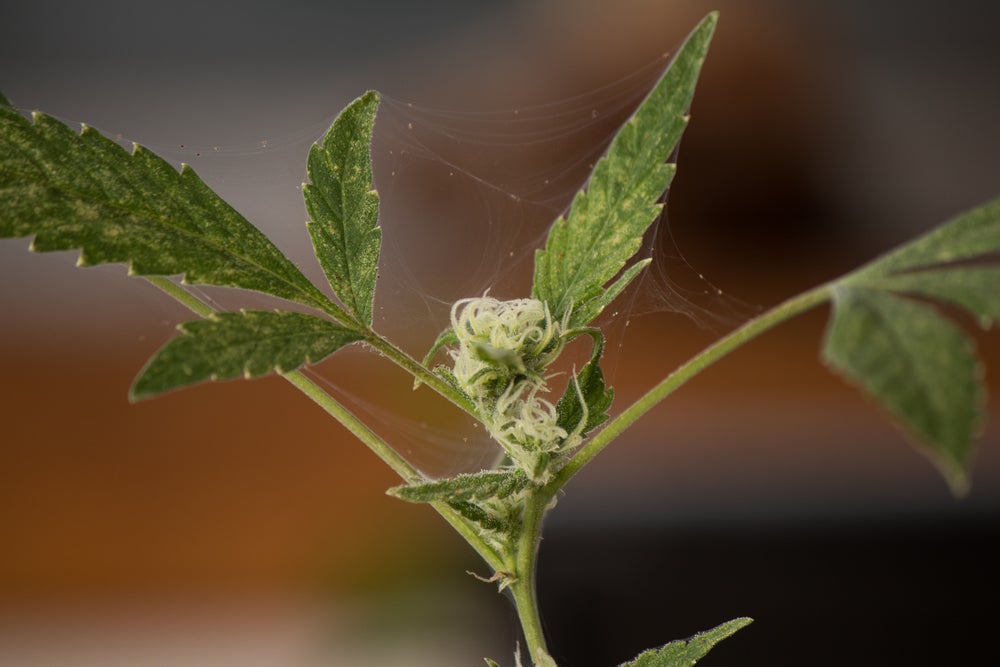Red spider mites are one of the most common and detrimental pests that cannabis growers face. These tiny arachnids, barely visible to the naked eye, can quickly infest your plants and wreak havoc on your crop. Left unchecked, spider mite infestations can severely impact yields and plant health. The good news is that with vigilance and proper treatment, red spider mites can be controlled and managed. Here we’ll explore some tips and techniques for getting rid of spider mites and keeping them away from your cannabis plants.
Identifying Red Spider Mites
The first step in managing spider mites is learning to identify them. Adults are only about 0.5mm long and have eight legs. They are usually reddish or greenish-yellow in color. The mites spin fine silken webs on the undersides of leaves, stems, and buds as they feed. These webs can cover and damage your plants.
Spider mites thrive in hot, dry conditions. Keep an eye out for the telltale webbing in arid environments or during summer growing. You may also notice yellowing or bronzed leaves and stunted plant growth as the mites siphon nutrients and water from the plant. If you suspect you have an infestation, shake a few leaves over a white piece of paper and look for tiny specks crawling about. Spider mites move quickly, so a hand lens or magnifying glass helps spot them.
Cultural and Mechanical Controls
The first line of defense against spider mites is prevention through cultural practices and mechanical control.
- Reduce plant stress – Spider mites attack unhealthy plants more vigorously. Avoid drought stress, overfeeding, and other suboptimal growing conditions.
- Control humidity – Mites thrive in hot, dry areas. Maintain moderate humidity around 50% to slow breeding.
- Remove dust – Dust builds up on leaves, creating habitat for mites. Regularly clean dust from leaves.
- Prune and thin dense growth – Dense growth retains humidity and prevents spray penetration.
- Use fans – Strong air flow dislodges and desiccates mites. Carefully aim fans at plants.
- Isolate infected plants – Quarantine and treat infested plants away from healthy ones.
- Discard heavily infested plants – Severely damaged plants may not be worth saving. Removing them can prevent spread.
- Take cuttings from healthy plants – If you must discard plants, take new cuttings first to preserve genetics.
- Sanitize grow area – After discarding plants, thoroughly clean the grow space before bringing in new plants.
Chemical Spider Mite Controls
When cultural controls fail to eliminate mites, chemical treatments are the next line of defense. A number of organic and synthetic miticides and insecticides can be employed:
- Insecticidal oils – These organic oils smother mites on contact. Examples include neem, canola, soybean, and cottonseed oils. Coat all plant surfaces thoroughly when applying.
- Insecticidal soaps – Soaps like potassium lauryl sulfate dissolve mites’ external skeletons. Hit undersides of leaves for best results.
- Sulfur – Sulfur disrupts mite metabolism when it contacts their bodies. It must be applied preventatively before infestations are severe.
- Pyrethrins – Pyrethrins are plant-derived pesticides that work as neurotoxins on mites. Repeated applications are needed as pyrethrins break down quickly.
- Azadirachtin – This organic neem-extracted insecticide deters feeding and disrupts molting and reproduction in mites. It offers residual activity after application.
- Abamectin – Abamectin is a potent miticide derived from soil bacteria. It’s effective at very low dosages but must contact mites directly.
- Bifenzate – Bifenzate impairs mites’ mobility and ability to feed. Apply it early at first signs of infestation. Repeat every 7-14 days if needed.
- Spiromesifen – This synthetic miticide inhibits lipid production, blocking growth and reproduction. It has residual activity lasting 7-28 days.
When using any chemical control, thoroughly coat all plant surfaces, especially the undersides of leaves where mites lurk. Follow all label directions for correct mixing, dosage, and application. Rotate chemical classes with each application to prevent resistance. Continue treatments for 1-2 weeks after mites are gone to kill newly hatched nymphs. Monitor closely and reapply if mites return.
Biological Control
For organic growers, natural biological control agents can combat spider mites without harsh chemicals. The two most common biocontrol options are:
- Predatory mites – Mites from genus Phytoseiulus prey exclusively on spider mites. Releasing them early can establish lasting populations on infested plants. They are compatible with organic sprays.
- Predatory insects – Ladybugs, lacewings, and minute pirate bugs all feed on spider mites. Multiple releases are needed as they fly away quickly. Their larvae are more effective for mite control than adults.
- The key with natural enemies is early preventative release before mite populations explode. Apply them according to label rates and re-apply as needed. Combining predators with organic sprays like oils and soaps can be an effective integrated pest management strategy for organic cannabis producers.
Winning the War on Spider Mites
Spider mites can be challenging adversaries for any cannabis grower. But by implementing preventative cultural practices, vigilant monitoring, and properly timed applications of miticides and biological controls, you can protect your crop and emerge victorious from the war on spider mites. Consistency and diligence are vital, as spider mites are relentless foes. But with concerted effort and the right combination of control methods, you can defend your garden from these ubiquitous pests.
For practical tips and advice on homegrown Cannabis, check out our posts on How Long Does It Take To Fully Grow A Cannabis Plant?, Advantages of Growing Cannabis Clones Vs Seeds, and How Much Cannabis Can I legally Carry In The Canada.












